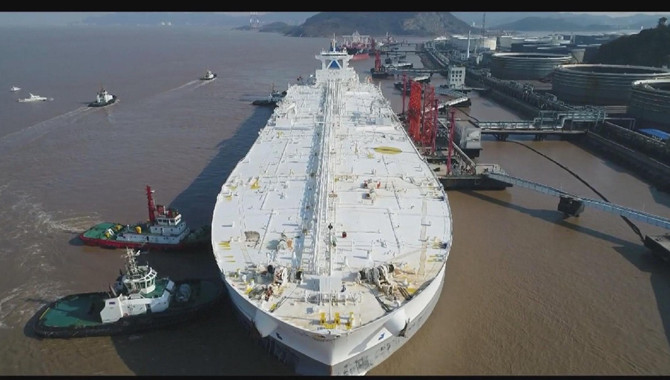
China's maritime shipping market has seen both weal and woe so far this year, with the container freight rate falling unexpectedly and the crude oil transportation market ushering in early peak season after long drought.
Fu Miaoling, who runs a tableware business in Yiwu City, the world's largest small commodities wholesale market in east China's Zhejiang Province, said she has found shipping costs falling once again.
"The cargo value for each container is usually between 200,000 yuan and 300,000 yuan (about 28,000 to 42,000 U.S. dollars), of which the freight rates account for about 10 percent. Now the sea freight is much lower, which means increase of at least three percentage points in the profit," Fu said.
It's usually a peak season for exports from July to September. However, the container freight rates kept declining instead of climbing, with some lanes even seeing sharp tumbles.
"The container freight rates slumped especially on the routes to the United States. In last September, Matson Clipper's shipping fee reached as high as 50,000 U.S. dollars per TEU, but now it is just over 10,000 U.S. dollars. That of the Red Sea, the Middle East, India and Pakistan routes are also declining," said Wang Pinghe, business manager of a supply chain in Zhejiang.
The latest Freightos Baltic Index (FBX) shows that the current price of a 40-foot container shipped on the route from China/East Asia to West Coast of North America stands at 3,024 U.S. dollars, which once surpassed 20,000 dollars last year.
On the contrary, the Shanghai Shipping Exchange's fright index of crude oil imports stood at 1,816.13 on Friday, up 15.41 from the previous period. Freight rates for Very Large Crude Carriers (VLCCS) from the Middle East to Ningbo City of east China's Zhejiang Province rose more than 15 percent in September from the previous month.
The recovery in crude oil shipments has aroused more demands for VLCCS .
On Saturday, a 300,000-ton super large tanker was officially delivered in Dalian City of northeast China's Liaoning Province after the final debugging.
"This is the third VLCC we have delivered so far this year. We still have two more on order and will deliver them in 2022 and 2023," said Yu Chengjiao, deputy director of the Materials Department of China State Shipbuilding Co., Ltd.
Dalian COSCO Khi Ship Engineering Co., Ltd. has taken orders for two dual-fueled VLCCs recently, before which China's supertanker shipbuilding market saw a depressed year without any new ship orders, Industry insiders explain that the order drought was cause by the continued downturn in the tanker market in that period. Global orders for VLCCS are still at historically low levels, even if the boom in oil shipments is giving the market a bit of a boost.
Analysts say that at present, a large number of orders on the shipbuilding market are mainly for liquefied natural gas (LNG) carriers, container ships, dry bulk carriers, but the slipways are in short supply, so the supply of VLCC tankers may be tight for some time.
Source: CCTV
The opinions expressed herein are the author's and not necessarily those of The Xinde Marine News.
Please Contact Us at:
media@xindemarine.com


 Ningbo Containerized Freight Index Weekly Commentar
Ningbo Containerized Freight Index Weekly Commentar  Ningbo Containerized Freight Index Weekly Commentar
Ningbo Containerized Freight Index Weekly Commentar  Ningbo Containerized Freight Index Weekly Commentar
Ningbo Containerized Freight Index Weekly Commentar  BIMCO Shipping Number of the Week: Bulker newbuildi
BIMCO Shipping Number of the Week: Bulker newbuildi  Ningbo Containerized Freight Index Weekly Commentar
Ningbo Containerized Freight Index Weekly Commentar  Ningbo Containerized Freight Index Weekly Commentar
Ningbo Containerized Freight Index Weekly Commentar